What comes with the set?
- 2 x 160mm rotors
- 1 x 180mm front post mount adapter
- 1 x 160mm rear post mount adapter
- 12 x rotor mounting bolts (steel)
- 6 x caliper mounting bolts (steel)
What does it weigh?
The Hygia SLP are Hygia's lightest disc brake set. My set has a total weight of 768g. The front brake weighs 246g and the rear 275g. This set has stainless steel braided brake lines which I understand are heavier than the standard brake lines.
Front brake - 246g

Rear brake - 275g
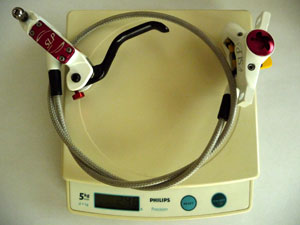
Rotors - 80g each
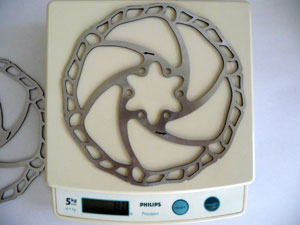
Hygia's weight claims
Hygia claims that the weight of the SLP lever assembly, caliper and rotor (ie. no brake lines) total 268g compared to 253g for Formula R1 and 347g for Shimano XTR (probably M975, but they don't specify). This seems an odd way of weighing things as it doesn't include the weight of the hose. If Hygia's figures are to be believed then the steel braided brake hose must weigh about 58g for the front and 87g for the rear.
What are they like?
Power and modulation are first class. They feel slightly more powerful than the XT brakes and the lever feel is firmer, perhaps because of the braided brake lines.
No worries using these brakes for single finger braking.
I have not had them fade or otherwise mis-behave. As a brake intended for XC they do the job, the price is right, the weight is OK.
Fit and finish is pretty good. My only criticism is that the levers look a little cheap - they seem to be made from pressed aluminium. They don't bend when applying the brakes but only time will tell how well they cope with normal wear and tear, particularly where the lever pivot and the brake plunger pivot is.
Left and right hand
The brakeset is not ambidextrous, so if you want to swap your front and rear brake from side to side (ie. from American style with the rear brake on the right to moto style with the rear brake on the left) then you will need to disconnect the hoses, swap the calipers over and then rebleed the system.
Some people have claimed to be able to swap hoses without needing a bleed, but bleeding these brakes is very straight-forward (see below).
What bleed kit can I use for the Hygia SLPs?
The Avid (or compatible) bleed kit works for the Hygia SLPs.
How do you bleed the Hygia SLPs?
I downloaded a user manual for the Hygia Usagi disc brakes that seem very similar to these but could not get the brakes bled following those instructions.
I was able to bleed the brakes using the following approach:
- loosen the bar clamp on the master cylinder/brake lever and rotate so that the bleed screw is top most;
- remove the caliper bleed screw and screw in the bleed adapter;
- connect bleed hose and insert into bleed jar;
- fill syringe with brake fluid and connect with hose to bleed adapter;
- push syringe plunger so that there is no air in the syringe, tube and bleed adapter;
- remove master cylinder bleed screw and screw in bleed adapter/syringe assembly;
- pump brake lever until contents of syringe (about 30ml of brake fluid) is flushed through the system and there are no air bubbles coming out of the caliper bleed port;
- if there are still air bubbles coming out of the bleed port then repeat the process with another syringe full of brake fluid.
Notes:
- you probably do not need to pump an entire syringe full of brake fluid through the system but you may as well because 30ml of brake fluid is cheap and flushing the system is always a good idea;
- use Dot 4 brake fluid - ideally "super Dot 4" which is a Dot 4 variant with a higher temperature rating than normal Dot 4 fluid so it will resist boiling better than standard Dot 4. This is important because of the very small volume of brake fluid in bicycle brake systems;
- use fresh brake fluid from a previously unopened container - Dot 4 brake fluid is hygroscopic (it absorbs water from the air) and water in the fluid will affect the fluid's temperature rating and can cause corrosion in the system. As little as 2% absorbed water will drop the boiling point of the brake fluid by 30%;
What brake pads do the Hygia SLPs use?
The Hygia SLPs use brake pads that are compatible with Shimano XTR. They come with semi-metallic sintered pads:
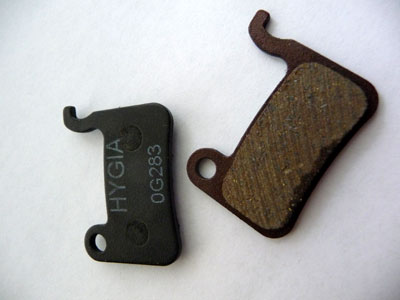
The pads weigh 18g. It is possible to shed some weight from the system by using A2Z ultralight XTR pads (at 11g each) or discobrakes ultralight pads (at 8g each).
How do I adjust the pad engagement point?
Pad engagement is adjusted using a 2mm allen key to turn the master actuator plunger. There is an access slot in the front of the brake lever so you can get at the 2mm allen head. Turning anti-clockwise will shift the engagement point closer to the handlebars.
The pad engagement point adjuster screw can be seen to the left of the red lever reach adjuster and through the slot in the lever in the picture below:

What sort of barbs and olives do the Hygia brake lines use?
At this stage I am not sure if the Hygia barbs and olives are the same as some other manufacturers. Here are some closup pictures:
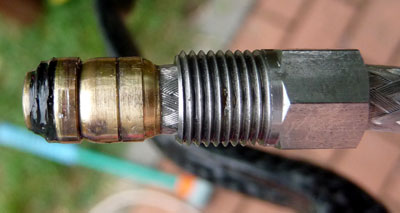
End on close-up:

What size is the Hygia SLP master cylinder and caliper piston?
The master cylinder plunger is 10mm in diameter. The caliper pistons are 21mm in diameter.
What's the tuning potential of the Hygia SLPs?
Even though the SLPs are a fairly light brake set to begin with, there is some tuning potential available (weight savings over stock components in bold):
- replace steel clamp bolt with aluminum bolt - the steel version is M6 x 1mm x 18mm long, an aluminum version in M6 x 1mm x 16mm is sufficient - weight saving for 2 bolts: 8g (cost: $3);
- A2Z ultralight XTR pads - weight saving for 2 sets of pads: 14g (cost: $28) or discobrakes ultralight pads: 20g (cost: $40);
- replace braided steel hose with Jagwire Hyflow hose (23g/m): 58g (cost: $30) or with discobrakes.com hose (19g/m): 67g (cost: $20);
- titanium mounting bolts - total weight saving: 20g (cost: $16);
- titanium rotor bolts - total weight saving: 8g (cost: $29.50);
- Shimano post mount rear adapter - total weight saving: 12g (cost: $10).
Total weight savings with all tuning options: ~134g
Final weight of complete brake set is ~634g
Total cost of tuning: $118.50
Total cost of tuned brakeset: $318.50
Note: You can get the non-braided version of the Hygia SLPs for less than the braided version which I got. If you intend replacing the stock hoses with Jaqwire Hyflow, then get the cheapest set (about $170 on fleabay instead of $200). If you do that then you're looking at a 650g brakeset for under $300. That's probably pretty hard to beat.
For more on tuning the Hygia SLP brakes see the Hygia SLP tuning article .
Upgrades
Carbon fiber levers
After bending the cheap aluminum brake lever I decided to make some replacement levers in carbon fibre . CF levers are available from Hygia for their Elite brakes but not at present for the SLP:

Wet weather performance
Performance of these brakes in the mud and wet seems good. Initial bite is slightly less but the design of the rotors seems to very quickly clean the pads and you get close to full power and modulation shortly after pulling the lever in.
The brakes do not squeal or otherwise make funny noises when wet.
I have also used the Hygia SLPs with some Jetblack / Ashima AiRotor lightweight rotors . Braking power with the Ashima rotors is significantly less than with the Hygia rotors. The AiRotors also squeal in the wet, something the Hygia's don't do.
With the Alligator Aries disc rotors there is also a little bit of squealing in the wet, particularly on the front.
Some observations...
The lever reach adjustment bolt unwinds itself as you ride. It has a small circlip fitted to the end to stop it from falling out, but I found it would continuously back out by itself while riding. A drop of loctite is the quick fix, but it does mean you lose the ability to change the reach on-the-fly. Another option would be to put a small spring underneath the bolt head to provide enough pressure to stop the screw from moving by itself.
The lever reach adjuster is the red bolt in the picture below:
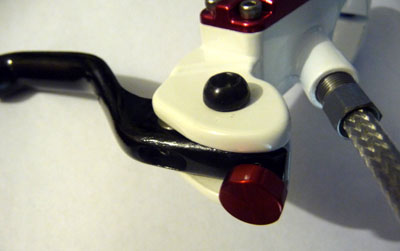
The levers themselves are the 'cheapest' part of the SLP brake system. They are made from pressed aluminium and weigh 9g. They are not anodized, but are painted black. I have already bent one lever in a crash and although I was able to bend it back into shape you can see fatigue cracks developing around where it was bent.
6 months on...
The brakes continue to perform really well. Over the last six months I've gone through two sets of rotors and half a dozen brake pads over about 4000km of offroad riding, much of that in wet and damp conditions.
In those sorts of conditions these brakes require a fair amount of maintenance:
- I have given them a full bleed every 3 months and each time the brake fluid has come out grey and full of contaminants. The first signs that the brakes need the fluid replaced are when they "pump-up" when they get hot. If you notice that occuring then its a sure sign that the fluid is contaminated (probably with water);
- the stock rotors wear out quickly. Indeed when it came time to replace the worn out stock pads I noticed that the rotors in the centre of the braking track were also worn below the wear thickness limit.